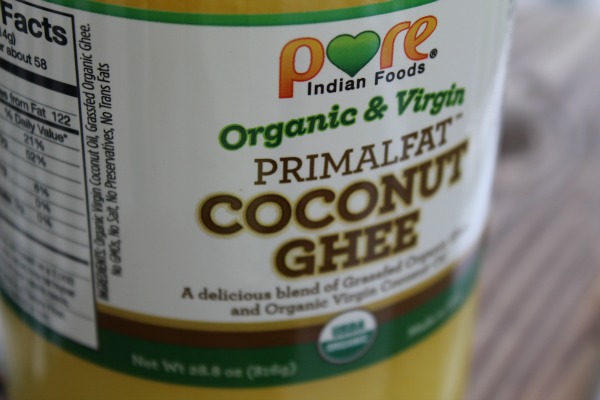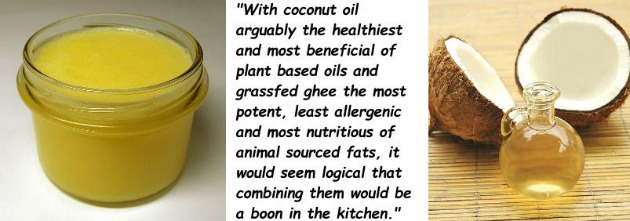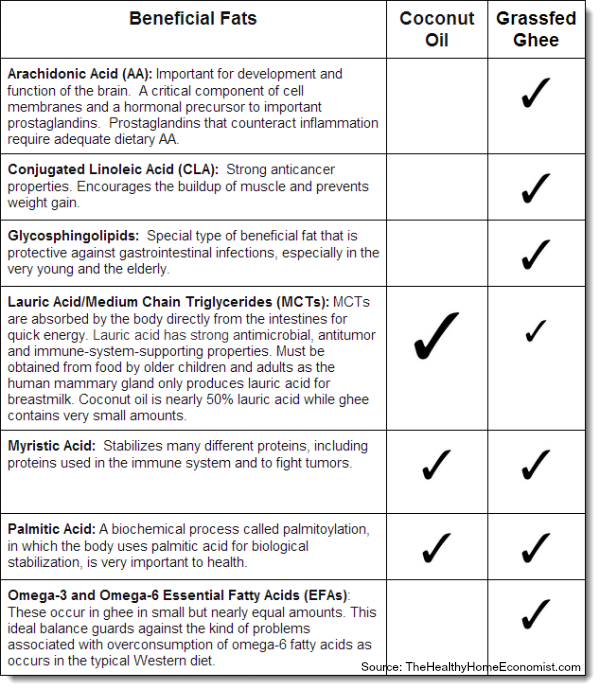Choosing the right fat for cooking and baking is absolutely essential to the overall success of a dish – not just in how it tastes, but how you feel after eating it.
Restaurants and bakeries today overwhelmingly use polyunsaturated vegetable fats for food preparation. These oils should never be heated at all let alone used for cooking or baking. Unless cold-pressed, these factory fats are already rancid in the bottle right off the store shelf, and even if a cold-pressed oil is used, the oil is destroyed and full of free radicals by the time the food is cooked with is served up on your plate.
Cooking requires fats that will maintain their integrity when heated and nourish the body rather than burden it with toxins.
For these reasons, both coconut oil and ghee have been perennial favorites in my kitchen for years.
Benefits of Coconut Oil
Coconut oil is full of medium-chain triglycerides (MCTs), which the body absorbs directly from the small intestines for quick energy. It is less likely to cause weight gain than polyunsaturated oils and has strong antimicrobial effects. MCTs are increasingly being utilized as nutritional therapy for those with Alzheimer’s, Parkinson’s, multiple sclerosis and other debilitating neurological diseases.
Coconut oil is highly stable, unlike polyunsaturated vegetable oils, so much so, that you can keep it unrefrigerated in your pantry for years and it will not go rancid (I have a 5-gallon bucket in my garage. It stays perfect through the long, hot, humid Florida summers). It remains stable and does not readily form free radicals even when heated making it an ideal cooking oil.
Ghee Advantages
Ghee is simply a must in the pantry of any Traditional Cook. Clarified butter as it is also known, has been used for thousands of years by Indian cultures for cooking. Traces of ghee have been found on fragments of Indian pottery dating as far back as 6500 BC!
Even those with a dairy allergy usually find ghee presents no trouble for them. This is because removing all the milk solids (proteins like casein) as well as the milk sugar (lactose) from the butter during the clarification process renders ghee a nonallergenic oil.
In addition, any water that is present is completely removed from butter when ghee is made which when combined with the removal of the milk proteins and lactose, greatly increases the smoke point. This makes ghee ideal for even high heat cooking as the purest ghee has a smokepoint of up to 485 F/252 C. According to my research, only refined avocado oil has a higher smokepoint than ghee.
Like coconut oil, ghee does not need refrigeration and keeps well on the counter or pantry for many months.
Note that ghee and butter oil are sometimes confused. The two are slightly different as butter oil is made from raw butter and ghee is usually not.
Best of the Best: Coconut Oil Blended with Ghee
 With coconut oil arguably the healthiest and most beneficial of plant-based oils and ghee the most potent, least allergenic and most nutritious of animal-sourced fats, it would seem logical that combining them would be a boon in the kitchen.
With coconut oil arguably the healthiest and most beneficial of plant-based oils and ghee the most potent, least allergenic and most nutritious of animal-sourced fats, it would seem logical that combining them would be a boon in the kitchen.
This is exactly what I discovered when I tried using a ghee/coconut oil blend for the first time. I love the intense butter flavor that ghee gives to food. At the same time, I also enjoy the moistness that coconut oil provides, particularly to baked goods.
Using this oil blend works beautifully for sauteing, frying up pancakes, cooking vegetables, and stir-frying. Higher heat uses such as grilled cheese sandwiches work too. Blending the ghee with coconut oil increases the smokepoint of the coconut oil so that the overall smokepoint of the blended oil is higher than coconut oil alone.
Healthy Array of Fats in Coconut Ghee
The beneficial fats in a quality Coconut Ghee blend made with virgin coconut oil and grass-fed ghee are many. Here are the main ones along with how they boost our health:
How to Best Use Coconut Ghee in the Kitchen
In summary, blending organic virgin coconut oil and grass-fed organic ghee together results in a nutritional powerhouse of fats. It not only delights the tastebuds, but it is healthful as well!
Here are a few ideas to get you started on how to optimally use this blended fat in your kitchen routine:
- Try using coconut ghee for sauteing vegetables or your favorite stir-fry.
- Use coconut ghee for all your baking needs. The intense butter flavor of the ghee combined with the moistness provided by the virgin coconut oil makes for the best pastries, bread, and cookies you’ve ever tasted.
- The high smokepoint of coconut ghee makes it suitable even for frying. Grilled cheese sandwiches and tuna melts made with coconut ghee are favorites in my home.
- Coconut ghee works well for those who follow a Paleo/Primal diet. Almond flour pizza crust, coconut flour pancakes, and grain-free cobblers all turn out moist and delicious using coconut ghee.
Where to Source Quality Coconut Ghee
The best coconut ghee is blended at a ratio of 1:1 in order to obtain equal benefit from each healthy fat. This proportion also minimizes the coconut flavor from the virgin coconut oil.
You can certainly go the DIY homemade ghee route by gently heating grass-fed butter. Skim to remove all the milk solids. Then, carefully blend in an equal amount of virgin coconut oil.
While this process is easy, it is a bit time-consuming. As a result, I was happy to discover a source for coconut ghee that is as high quality as anything I would make myself.
PRIMALFAT Coconut Ghee from Pure Indian Foods combines organic virgin coconut oil with grass-fed organic ghee in a very smooth, high-quality blend. The pastured butter used to make the ghee comes only from cows eating rapidly growing Spring and Fall grass. This is the most nutrient-dense pasture possible.
Coconut Ghee is a perfectly nutritious and delicious cooking fat for anyone who espouses Traditional Diet including those with a Paleo/Primal dietary preference.
Two sizes are available, a 14.2 oz jar and a 28.8 oz family size. I prefer the larger size as I tend to do batch cooking to save time.
If you’ve been using pastured butter and coconut oil in your kitchen, try the PRIMALFAT Coconut Ghee. It works beautifully for any and all cooking and baking needs. Taste for yourself the improved flavor and texture of food cooked with a blend of the most beneficial fats from both plant and animal sources.
References
(1) The Skinny on Fats
(2) Eat Fat Lose Fat, by Dr. Mary Enig and Sally Fallon Morell
Pure Indian Foods paid a sponsorship fee for this post. However, the views and opinions expressed are solely those of The Healthy Home Economist.










Sarah, I think its important to mention that only a refined avocado oil will exceed a smoke point of 500+ degrees. Virgin avocado oils smoke much closer to 425F or even much lower depending on the age of the oil.
Sarah, while I love all the animal fats, I’m intrigued by the fat content of coconuts and avocados. I know you talk about avocado oil in your fantastic e-book on fats. Is avocado oil one of those fats where you need to investigate how a particular brand is processed in order to know if it’s good to use? Can it be subjected to the heat of cooking?
Is there any reason *not* to use grapeseed oil? I have plain and garlic infused versions I have been using for salad dressings for a few years now. am I missing some reason that we should not be using it?
Grapeseed oil is extremely high in omega 6 fats .. those fats that should only be obtained from the diet in small amounts and that Westerners already get too much of via the modern diet. It is best to not use grapeseed oil.
This is very interesting. I never tried coconut ghee before since I always use plain coconut oil for cooking. I would like to try this product. Thanks! 🙂
That brand is far too expensive. Much cheaper to make it at home.
I already use coconut oil and ghee in my cooking but I am still confused about what kind of oil to use in salad dressings or marinades that ends up in the frig. Coconut oil and ghee turn hard in the frig and don’t want that happening to a marinade or salad dressing. I don’t always like to use olive oil because of it’s strong flavor. What is another oil that could be used that is healthy, is not damaged when heated, and does not turn hard when cold? I have used walnut oil and grape seed oil but still not sure if those are good choices.
You could try Sesame Seed Oil from Wilderness Family Naturals, which is nice and mild, stays liquid in the frig and can be heated. Rendered lard from pasture-raised pigs stays soft in the frig, though not liquid. You could experiment with combinations of these for marinades. For salad dressings with olive oil, I just take the dressing out of the frig an hour or so before using it, and store it in something I can shake. The WFN sesame oil is great in dressings as well. They also have Mary’s blend, named after Mary Enig, which you might enjoy.
I buy very little commercially and go to great lengths to get grass fed raw milk to make my butter. Hence, I don’t generally use the butter in anything that requires heating as all those beneficial enzymes are destroyed. Other than adding a buttery taste to sauteed and baked goods there are really no nutritional improvements in Ghee, are there?
This looks great. I currently use ghee and or organic palm shortening in all my baking. I also use the palm shortening for frying. Should I change my ways?
Palm oil is fine and a very healthy, traditionally used tropical oil. Try coconut ghee and see what you think. Palm oil is mostly monounsaturated fat with a lot of palmitic acid which is healthy blend … but it would be very beneficial to add the additional healthy fatty acids to your diet contained in coconut ghee (see chart above).
Green Pastures (the people who make and sell fermented cod liver oil) also have a coconut ghee that I have been using for years. It might be a bit heavier on the coconut oil than the ghee. It is extremely reasonably priced and I love it!
The Green Pastures product is not 50-50 virgin coconut oil/ghee blend and so has a much more pronounced coconut flavor. It is no less than 75% virgin coconut oil from what I understand. Also, the butter wax is included in the Green Pastures coconut ghee which gives it more texture on the tongue. This product is wonderful .. but is quite different than a 50-50 coconut ghee where the ghee is pure clarified butter with no butter wax.
Good to know. Thanks, Tina
I’ve used theirs and it’s very good. Love it on popcorn!
While that looks fabulous, it is much more expensive than either the grass fed ghee or coconut oil I purchase that I am very happy with. I have both sitting beside my stove top that I have generally used individually for cooking, why not just spoon a scoop of each into the pan when cooking, or measure out half and half when baking? Seems like it wouldn’t have to be blended before cooking or mixing into your baked goods to get the same benefits, would it? As always thanks for the info!
Of course you can make it yourself. It is just time consuming in my experience. If you have the budget for it, buying is a very good option as the PRIMALFAT coconut ghee is as good a quality as you would make yourself. In fact, the company’s owner makes it herself in small batches.